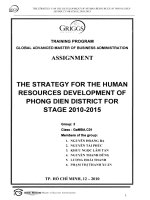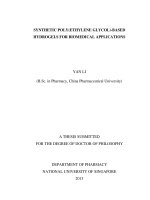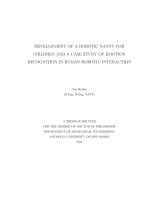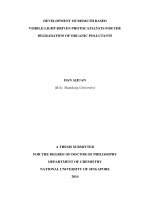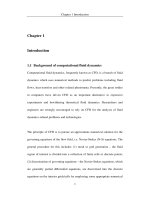Development of membrane based electrodes for electroanalytical applications 2
Bạn đang xem bản rút gọn của tài liệu. Xem và tải ngay bản đầy đủ của tài liệu tại đây (272.39 KB, 27 trang )
2 CHAPTER 2
Development of an electrode-membrane-electrode
system for selective faradaic response towards
charged redox species
2.1 INTRODUCTION
Development of highly sensitive and selective sensors is urgently needed
in many applications including environmental studies, health and biomedical
fields, to respond to recent global environmental and impending health related
issues [1]. Electrochemical sensors, in particular, are highly promising due to
their simple designs, low costs and possibility for miniaturization and
portability [2]. However, it should be noted that the electrochemical sensors
are either highly specific such as immunosensors [3] or provide indiscriminate
sensing response towards a wide range of analyte species such as
flow-injection sensor [4]. Development of an electrochemical sensor capable
of specific identification of wide range of compounds remains a challenge.
Several methods of modifying electrodes with catalytic properties to give
38
resolved peaks of analytes with thermodynamically similar redox properties,
by either changing their kinetic or thermodynamic behaviours via interaction
with the modifier layer, were reported [5]. Other methods include using
charged polyelectrolytes to change the surface properties of electrochemical
sensors, hence help differentiate between differently charged species by
varying their transport across the charged modifying films [6].
It was reported that surface charges along nanochannel walls facilitated
differential transport of proteins [7-9], amino acids and charged redox species
[10] across membrane structures. Additionally, several recent works by White
and co-workers demonstrated the use of electrostatic and photochemical
controls for specific transport of charged species [11, 12]. Yamaguchi et al.
found that the diffusivities of ferrocenes inside silica-surfactant nanochannels
formed within a porous alumina membrane template [13] were influenced by
electrostatic interaction between the charged species and the ionic charges
along the nanochannel walls. Early works by Martin et al. and Stroeve et al.
have reported the use of transmembrane potentials to produce the driving force
for electrophoretic separation of proteins across gold-plated nanotube
membranes, using an externally applied electrical field placed some distance
39
away from the membranes [7, 14].
Herein, anodic nanoporous alumina membrane (Whatman) was
employed as the separation membrane. Our approach involves constructing an
electrode-membrane-electrode system by sputter coating a 60µm thick
alumina membrane with metal on both sides. The electrical field is applied
directly across the channels within the membrane. This has the advantage of
achieving high field strengths of ca. 30 kVm
−1
but with very low applied
potentials of ca. 2V between the platinum-coated layers [15]. The platinum
coatings function as working electrodes by connection to a bipotentiostat and
reference/auxiliary electrodes in the cell solution. The membrane electrodes
system has been used to study electrophoretic mobility of gold nanoparticles
with different sizes [16] transport of proteins and selective separation of
proteins of different charges [15]. In this work, the mobilities of charged
species moving within the nanochannels of the alumina membrane electrodes
system were measured. In addition, simultaneous electrochemical sensing
towards three ferrocene species, ferrocenemethannol (FcMeOH),
ferrocenecarboxylic acid (FcCOOH) and (dimethylaminomethyl)ferrocene
(FcN), can be readily achieved under the same conditions which control the
40
species mobilities when the electrical potential field applied across the
membrane was varied.
2.1.1 Ferrocene and derivatives
Ferrocene is an organometallic sandwich compound consisting of a Fe
(II) center and two symmetrically bound cyclopentadienide ligands. Ferrocene
can be oxidized to a ferrocenium cation Fe(III) under appropriate oxidation
potential. Because of facile electron transfer of ferrocene during
electrochemical reactions, ferrocene and its substituted derivatives are
commonly used as redox probes and mediators. Furthermore, by replacing the
hydrogen atoms with electron-donating or electron-accepting groups, the
reversible potential can be shifted to more negative or positive potential,
respectively. One such ferrocene derivative is ferrocenemethanol which is
soluble in aqueous solutions. At neutral solution pH 7, FcMeOH is uncharged.
In contrast, another water-soluble derivative, the ferrocenecarboxylic acid
(with pK
a
=
4.2) loses proton and assumes negative charge at pH 7. The third
ferrocene derivative used in this work is (dimethylaminomethyl)ferrocene
(pK
a
=9.84 )which has a positive charge at pH 7. Structures of the three
ferrocene derivatives used in this work are shown in Table 2.1.
41
Table 2.1 Structures of (A)FcMeOH, (B) FcCOOH, (C)FcN and their charge
in phosphate pH 7 buffer.
Ferrocences
Fe
HO
Fe
O
O
Fe
NH
Charge Neutral Negative Positive
2.1.2 Collection experiment
Collection experiment is a commonly used technique for rotating
ring-disk electrode. In collection experiment, the disk generated species can be
observed at the ring electrode surrounding the centrally placed disk electrode.
In general, collection experiment is carried out by keeping the disk electrode
potential at E
D
such that a redox reaction takes place O + ne
-
→ R which
produces the cathodic current i
D
. At the same time, the ring electrode is held at
sufficiently positive potential so that any R produced at the disk electrode
reaches the ring will be oxidized immediately R → O + ne
-
and produces the
anodic current i
R
. Ideally, the concentration of R at the ring electrode is kept at
zero so that quantitative information concerning the amount of disk-generated
product collected at the ring can be derived. The collection efficiency, N, can
42
be obtained from the ratio of ring current to the disk current:
R
D
N
i
i
−
=
Fig. 2.1A shows the ideal ring and disk currents obtained from a redox
couple during a collection experiment in which the disk electrode potential E
D
,
is swept cathodically, while keeping the ring potential E
R
sufficiently more
positive than the formal potential at diffusion limiting condition.
Fig. 2.1 (A)Voltammogram showing i
D
vs. E
D
and i
R
vs. E
D
with E
R
= E
1
during a typical collection experiment (B) i
R
vs. E
R
, i
D
=0 (E
D
=E
1
) and i
R
vs. E
R
(E
D
=E
2
)
43
2.1.3 Shielding experiment
The shielding experiment is also used for the rotating ring-disk electrode.
While collection experiment sweep the disk electrode potential and keep ring
potential constant, in the shielding experiment, the ring potential is scanned
while disk potential is held at open circuit potential and other constant
potentials. In this way, one can measures the ring current as function of ring
potential and study how much of this ring current is shielded when the disk
potential is held constant at different values (Fig. 2.1B). In detail, at first
instance, the current at the ring electrode ( ) is generated by sweeping the
ring potential to reduce O to R while the disk is kept at open-circuit condition.
During subsequent sweep of ring potentials, the disk potential is held at other
constant potentials such that the flux of O to the ring will be reduced (
i
0
i
R
D
R
). The
amount of shielding of the ring current can be correlated to
Ni
D
, the flux of the
stable product
R to the ring during the collection experiment (Fig. 2.1B):
0
RR
Nii i=−
Some dual electrode systems that achieve steady-state conditions can
similarly show the shielding and collection effects, such as in microelectrodes,
microarrays and scanning electrochemical microscopy (SECM). In our
44
electrode-membrane-electrode system, the collection and shielding
experiments were employed to study the transport of different redox charged
species from one of the membrane-coated porous Pt electrode layers to the
other, as the redox species traverse through the membrane nanochannels. The
significance of these experiments is to demonstrate the possibility of carrying
out simultaneous selective resolution and quantitation of differently charged
analytes using the electrode-membrane-electrode system.
2.2 EXPERIMENTAL
2.2.1 Materials and Reagents
Ferrocenemethanol (FcMeOH), ferrocenecarboxylic acid (FcCOOH) and
(dimethylaminomethyl)ferrocene (FcN) were obtained from Sigma-Aldrich.
All ferrocenes were prepared in 0.1 M phosphate pH 7 buffer. 25 mm diameter
nanoporous alumina membranes (Anopore) were obtained from Whatman
(Maidstone, Kent, UK). The membrane had a thickness of 60 µm and nominal
pore size of 100 nm with a porosity of 25 to 50%. All membranes were
washed and pre-treated with 35% hydrogen peroxide (Scharlau) and
subsequently sputtered with platinum (99.99% purity).
45
2.2.2 Instruments
Fig. 2.2 Schematic of membrane electrodes cell and detail of membrane
electrode at receiver face. The reference and auxiliary electrodes were placed
within the feed solution (for collection experiments) or receiver solution (for
shielding experiments). The membrane electrodes were connected to working
potentials 1 and 2 of the bipotentiostat. Solutions were stirred throughout the
experiment.
All transport experiments were performed using a membrane cell with
two compartments (feed and receiver) (
Fig. 2.2). The metal coated membrane
was clamped between the two half cells using silicon O-rings as sealants. A
bipotentiostat (CHI 900) with four electrode system was employed for all
experiments. Platinum coated feed face and receiver face of the alumina
membrane were used as two working electrodes. Potential was applied to the
Membrane electrodes
WE2WE1RE
CE
Receiver Feed
Bipotentiostat
Nanochannels within
alumina membrane
Membrane electrode at
receiver face
46
membrane through two aluminum tape attached to the membrane electrodes.
Platinum wire and Ag/AgCl/KCl (saturated) were used as auxiliary and
reference electrodes respectively.
2.2.3 Experimental procedure
The metal-coated membrane was left in contact with the solutions for ca.
5 min before the start of experiment. All experiments were carried out at room
temperature. For cyclic voltammetry experiments, the ferrocene solutions
contained 2.5 mM ferrocene species in 0.1 M phosphate pH 7.0 buffer and
only one of the membrane electrodes is monitored to derive the
current-voltage curves.
2.2.3.1 Collection Experiments
Collection experiments were carried out in the membrane cell where the
feed compartment contained 2.5 mM ferrocenes in 0.1 M phosphate pH 7.0
buffer and the receiver compartment contained the same buffer solution.
Both reference and auxiliary electrodes were placed in the feed solution. The
potential at the feed electrode, E
f
, was swept at slow scan rate of 10 mV s
-1
in
the range of 0.3 to 1.0 V versus Ag/AgCl/KCl(sat). The receiver electrode was
47
maintained at constant potential of 0 V (E
r
), any oxidized species reaching the
received face was reduced. The magnitude of the receiver current i
r
under
these conditions relates directly to the amount of oxidized ferrocene moving
through the nanochannels of the membrane electrodes.
2.2.3.2 Shielding Experiments
In the shielding experiment, the reference and auxiliary electrodes were
placed within the receiver solution. The feed compartment contained 2.5 mM
ferrocene species in 0.1 M phosphate pH 7.0 buffer and the receiver
compartment contained the same buffer solution. The feed electrode was held
at open circuit or at 0.7 V to achieve limiting feed current values, while the
receiver electrode was scanned from 0.3 to 1.0 V.
2.3 RESULTS AND DISCUSSION
2.3.1 Cyclic voltammograms of ferrocenes at membrane electrode
system
Fig. 2.3A shows the cyclic voltammograms obtained for the three ferrocene
species. At the scan rate of 100 mV s
-1
, sigmoidal shape voltammograms were
obtained for all three ferrocenes. From the previous scanning electron
48
microscopy studies, the electrode surface morphology closely resembled the
regularly spaced porous alumina structure, but with pore sizes reduced by ca.
40% [
15]. The sigmoidal shape of the voltammograms is attributed to the
rapid mass transfer of the redox species to electrode surface with regular
arrays of sub-micrometer dimensions [
17, 18]. At the potentials where the
currents reached limiting values, the faradaic currents varied linearly with
concentrations of ferrocenes (
Fig. 2.3B), as expected for mass transfer limited
behaviours. The slope of the linear curve presents diffusion coefficient of the
ferrocene. Diffusion coefficients of FcMeOH and FcCOOH are similar and
larger than that of FcN. It may be due to the bigger size of FcN than that of
two other ferrocenes. The background capacitance and water reaction could
occur at the large surface electrode system and cause the current when the
concentrations of three ferrocenes are zero. The formal potentials of ferrocenes
obtained at the membrane electrodes system differed slightly from those
obtained at a disk platinum electrode due to the large surface area of
membrane electrodes system (1.13 cm
2
), giving larger iR
soln
drop in the bulk
solution. Compensation of iR
soln
drop during or after cyclic voltammetry
experiments gave the expected formal potentials of all three ferrocenes.
49
-1.5
-1
-0.5
0
0.5
1
1.5
-0.2 0 0.2 0.4 0.6 0.8
E
vs Ag/AgCl (V)
Current (mA)
FcMeOH
FcCOOH
FcN
A
R
2
= 0.9552
R
2
= 0.9764
R
2
= 0.9766
0.0
0.1
0.2
0.3
0.4
0.5
0.6
0.7
0.00.10.10.20.20.
Concentration (mM)
Current (mA)
B
3
FcCOOH
FcN
FcMeOH
Fig. 2.3
(A) Cyclic voltamograms of 2.5 mM ferrocene species at scan rate of
100 mV s
-1
at the membrane electrode. (B) Linear response of the membrane
electrode derived from the limiting current values for ferrocenemethannol
(FcMeOH), ferrocenecarboxylic acid (FcCOOH) and (dimethylaminomethyl)
ferrocene (FcN). Conditions: 0.1 M phosphate buffer (pH 7.0), T= 298K.
2.3.2 Collection experiments
In voltammetric techniques, migrations of redox species are generally
minimized by addition of electrolyte salts in order to simplify the limiting
50
mass transfer process to diffusion, besides several other obvious advantages.
Under this situation, a significant proportion of the potential drop is confined
to the double layer at the working electrode, at which Faradaic processes occur.
Large potential drop in the diffuse region between the working electrode and
reference electrode may occurs when the working and reference electrodes are
placed some distances apart or in solutions of low conductivities. In addition,
it was reported that the diffusitivities of metal ions and neutral species through
the nanosized channels within the nanoporous alumina membrane are
significantly lower by 1 to 2 orders of magnitude, compared to those of bulk
solutions [
13]. These have been ascribed to attractive interactions between the
diffusing molecules and the channel walls which slow down mass transport
within the nanosized channels. Therefore, it is expected that the electrolyte
solution within the nanoporous alumina membrane gives lower conductivity
compared to bulk solution, since movement of ions is lower within the
nanosized channels. In this work, we placed the nanoporous membrane
between the working and reference electrodes to introduce an uncompensated
resistance which gave rise to a potential drop across the membrane during
electrochemical reactions. We are interested to use this uncompensated
51
potential drop to influence the transport of charged species within the
nanochannels. This situation is readily achieved by placing the reference
electrode within one compartment of the membrane cell while the membrane
electrode facing the second compartment is connected to the working potential
of a potentiostat. To evaluate the magnitude of the resistance within the
membrane, cyclic voltammetries of ferrocenemethanol at a membrane
electrode were carried out in 0.1 M pH 7.0 buffer solution with the reference
electrode placed in the feed or receiver solution of the membrane cell.
Comparison of the 2 voltammograms using digital compensation of iR
u
drop
gives the uncompensated resistance within the nanoporous membrane, R
u,m
.
Average R
u,m
derived from several membrane electrodes is ca. 110 Ω . This
gives a solution conductivity of 5×10
-5
S cm
-1
(membrane thickness = 60 μm;
area = 1.13 cm
2
) which is ca. 2-3 orders of magnitude lower than the
conductivity of a 0.1 M phosphate buffer solution.
Collection experiments were carried out in the membrane cell for the
three differently charged ferrocenes (
Fig. 2.4A). The ferrocene in the bulk
solution of the feed compartment was first oxidized at the feed electrode,
moved across the membrane and was reduced at the receiver electrode held at
52
reducing potential of 0 V. The collection efficiency N measures the fraction of
oxidized ferrocene species arriving at the receiver electrode and is calculated
using the ratio of i
r
/i
f
(Fig. 2.4B). The current detected at the receiver electrode,
i
r
, arises from the reduction of oxidized ferrocene species which have moved
through the nanosized channels under the influence of electrical potential
gradient (
x∂
∂
φ
). The current at the receiver electrode can be described by the
following Nernst-Planck migration-diffusion equation [
19]:
x
FAuCzi
r
∂
∂
=
φ
+
x
c
nFAD
∂
∂
Eqn. 2.1
where
i
r
is the receiver current, u is ion mobility within the nanochannel, z is
charge of the charged redox species,
C is concentration of the oxidized species,
D is diffusion coefficient of the species within the nanochannels,
x
c∂
∂
is the
concentration gradient at the receiver electrode and
n, F, A have the usual
meanings.
53
-0.6
-0.4
-0.2
0.0
0.2
0.4
0.6
0.8
1.0
0.2 0.3 0.4 0.5 0.6 0.7 0.8 0.9 1.0 1.1
E
f
vs Ag/AgCl (V)
Current (mA)
FcMeOH
FcCOOH
FcN
i
f
i
r
Best fit data
A
0
0.1
0.2
0.3
0.4
0.5
0.6
0.7
0.5 0.6 0.7
E
f
vs Ag/AgCl (V)
Collection Efficiency, N
+FcCOO-
+FcMeOH
+FcN+
B
Fig. 2.4 (A) Collection experiments carried out with ferrocenemethannol
(FcMeOH), ferrocenecarboxylic acid (FcCOOH) and (dimethylaminomethyl)
-ferrocene (FcN). Potential at feed electrode,
E
f
, is swept at a slow scan rate of
10 mV s
-1
while potential at receiver electrode, E
r
is held constant at the
reducing potential of 0 V. Reference and auxiliary electrodes are placed in the
feed solutions. Experimental data of receiver currents
i
r
obtained at E
f
=
0.5-1.0 V are fitted to
Eqn. 2.2 (points). For neutral species
+
FcCOO
-
, the
second diffusion term in
Eqn. 2.2 applies and l is set to l
m
. See text for best
fitted parameter values of
u, D and l. (B) Collection efficiency derived from
(A), is calculated from the ratio of receiver current to feed current,
i
r
/i
f
.
54
For a membrane placed between the working and reference electrodes,
the electrical potential difference (
ΔE) across the membrane which influences
the migration rate is derived from the uncompensated resistance (
R
u,m
) within
the membrane which could be assumed to drop linearly across the membrane
thickness (
l
m
). ΔE relates to the measured current i
r
as ΔE = i
r
R
u,m
. In contrast,
the concentration gradient is not linear across the membrane and is more
appropriately represented by
l
C
where l varies, depending on the influence
of both migration and diffusion mass transport. Thus, the current at the
receiver electrode is simplified to:
m
r
l
E
FAuCzi
Δ
= +
l
C
nFAD
Eqn. 2.2
During collection experiments, the ferrocene species were oxidized at
the feed electrode to
+
FcMeOH,
+
FcCOO
-
and
+
FcN
+
with +1, 0 and +2 overall
charges, respectively. The feed and receiver solutions were constantly stirred
during the experiments to maintain uniform concentrations in the area close to
the membrane electrode surfaces.
Fig. 2.4A shows the non-linear curve fit data
of the experimental results derived from the collection experiments at
potentials 0.5-1.0 V and theoretical values calculated from
Eqn. 2.2 for the
55
oxidized ferrocenes. A factor of
-FcCOOf,
speciesfc f,
+
i
i
is added to Eqn. 2.2 to offset the
receiver current with respect to the feed current of the neutral species
+
FcCOO
-
, since different ferrocene species gave different responses at the
membrane electrodes system (see the various
i
f
in Fig. 2.4A). The comparison
of Eqn.2.2 with the experimental
i
r
was carried out at the higher feed
potentials, since these yielded limiting feed currents where concentrations of
the oxidized species generated at the feed electrode was similar to bulk
concentrations of the reduced species. The fitted results (points in
Fig. 2.4A)
gives ion mobility values of (6.3
+ 0.4)×10
-5
cm
2
s
-1
V
-1
and (2.9 + 0.2)×10
-5
cm
2
s
-1
V
-1
for single charged
+
FcMeOH and double charged
+
FcN
+
,
respectively; and diffusion coefficient value of (1.7
+ 0.1)×10
-7
cm
2
s
-1
for
neutral
+
FcCOO
-
. The corresponding diffusion coefficients of
+
FcMeOH and
FcN
+
derived from the relation
RT
FDz
u
= [19] are (1.6 + 0.1)×10
-6
and (3.8 +
0.3)×10
-7
cm
2
s
-1
respectively. These diffusion coefficient values are 4 to 15
times lower than reported values of the reduced forms [
13]. The best fitted l
values for
+
FcMeOH and
+
FcN
+
are 60 + 9 µm and 20 + 5 µm, respectively,
which indicate a thinner diffusion layer for the doubly charged
+
FcN
+
, due to
faster mass transport under the influence of the favourable electrical field
56
gradient.
There are two interesting results derived from the collection experiments.
First, the feed currents of the unoxidized ferrocenes FcN
+
and FcMeOH show
increasing currents at potentials between 0.6 V and 1.0 V (
Fig. 2.4A). In
contrast, steady-state voltammetry carried out at the same membrane electrode
system in the absence of a reducing potential at the receiver electrode gives
fairly constant currents in the same potential range (
Fig. 2.3A). The difference
in current response under the two conditions is attributed to a regeneration of
reduced species at the receiver electrode when a reduction potential is applied
at the receiver electrode. This adds to the flux of reduced ferrocene species at
the feed electrode, giving rise to feedback currents. Thus, a factor of
-FcCOOf,
speciesfc f,
+
i
i
is added to
Eqn. 2.2 in order to offset this effect of feedback currents at both
the feed and receiver electrodes. Second, the significantly different collection
efficiencies obtained for different ferrocenes indicate the membrane electrodes
system is able to discriminate the positively charged
+
FcN
+
from the neutral
+
FcCOO
-
by a large selectivity factor of ca. 16 times. Herein, the selectivity
factor is referred to as the ratio of collection efficiencies of charged species
57
(
+
FcN
+
or
+
FcMeOH) with respect to neutral species (
+
FcCOO
-
). Our previous
work using the alumina membrane system has shown that nanoparticles of
different size-to-charge ratio could be differentiated based on electrophoretic
transport rates under the influence of variable electrical potential gradient
applied directly across the membrane electrodes system [15, 20]. We further
carried out the following shielding experiment to measure the collection
efficiencies of the ferrocene species under the condition where the receiver
electrode was held at higher potentials relative to the feed electrode.
2.3.3 Shielding experiments
Fig. 2.5 shows the results of the shielding experiments for the three ferrocene
species. When the feed electrode was held at 0.7 V, the receiver currents were
lower compared to those obtained at open circuit potential of the feed
electrode. This is due to the arrival of some oxidized ferrocenes which could
not be oxidized further at the receiver electrode. Thus the difference in the two
currents is a measure of the fraction of oxidized ferrocenes collected at the
receiver electrode,
Ni
f,lim
, where i
f,lim
refers to the limiting oxidation current at
the feed electrode held at 0.7 V. Collection efficiency is calculated from the
58
ratio of this current difference and the limiting current at the feed electrode
held at 0.7 V (
Ni
f,lim
/i
f,lim
). Fig. 2.6 shows the collection efficiencies for the
three oxidized ferrocene species, derived from the shielding experiments.
Unlike the collection experiments where the receiver electrode was held at
more negative potentials relative to the feed electrode, in the shielding
experiments, the reverse potential gradient condition was applied. The
collection efficiencies of oxidized ferrocene species remained somewhat
unchanged at potentials less than 0.6 V. At the high potentials of 0.7-1.0 V, the
collection efficiencies of
+
FcN
+
and
+
FcMeOH decreased with potential due to
the influence of an unfavourable electrical potential field. In contrast, the
collection efficiency of
+
FcCOO
-
increased from 0.6 V to 0.8 V and remained
relatively constant from 0.9 to 1.0 V. This is likely due to some favourable
electrostatic interactions between the COO
-
group of the bipolar
+
FcCOO
-
molecule and the electrical potential field. Overall, the membrane electrodes
system achieved 3 to 4 times higher selectivity for
+
FcCOO
-
compared to
+
FcN
+
and
+
FcMeOH when the receiver electrode was held at positive
potentials relative to the feed electrode.
59
0.2 0.4 0.6 0.8 1
E
r
vs Ag/AgCl (V)
Current
0.25 mA
FcCOO
-
FcMeOH
FcN
+
Fig. 2.5 Shielding experiments for the three differently charged ferrocene
species. Potential at the receiver electrode,
E
r
, is swept at slow scan rate of 10
mV s
-1
while potential at the feed electrode, E
f
, is held at open circuit, o.c.
(
⎯) and at + 0.7 V (
_ _ _
) which gives limiting feed current. Reference and
auxiliary electrodes are placed in the receiver solutions.
0.0
0.1
0.2
0.3
0.4
0.6 0.7 0.8 0.9 1.0
E
r
vs Ag/AgCl(V)
Collection Efficiency, N
+FcCOO-
+FcMeOH
+FcN+
Fig. 2.6 Collection efficiency derived from shielding experiments.
Collection efficiency is calculated from the ratio of {
i
r
(o.c.)-i
r
(0.7V)}/i
f
(0.7V).
60
2.4 CONCLUSIONS
A method to measure the mobility of charged redox species moving
through nanochannels within a membrane electrodes system is described. The
method employed the uncompensated resistance within the membrane due to
slow mass transfer of ions, in order to introduce a significant electrical
potential drop across the membrane. Collection and shielding experiments
carried out within a two-compartment membrane cell showed selective mass
transport of the ferrocene species moving across the membrane, based on
species charges. High selectivity factors between 3 to 16 times were readily
achieved in solutions containing high concentration of 0.1 M electrolyte by
applying different working potentials at both membrane electrodes using a
bipotentiostat. This method of tuning the working potentials of an
electrode-membrane-electrode system to influence selective mass transfer of
the charged analytes is useful in differentiating between positively and
negatively charged redox species. Works are progressing towards
miniaturizing the electrode-membrane-electrode system to reduce capacitive
currents which presently limit its sensitivity.
61
REFERENCES
1. Shannon, M.A., P.W. Bohn, M. Elimelech, J.G. Georgiadis, B.J.
Marinas, and A.M. Mayes, Nature, 2008.
452(7185): p. 301-310.
2. Halliwell, C.M., E. Simon, C S. Toh, P.N. Bartlett, and A.E.G. Cass,
Biosensors and Bioelectronics, 2002.
17(11-12): p. 965-972.
3. Koh, G., S. Agarwal, P S. Cheow, and C S. Toh, Electrochimica Acta,
2007.
53(2): p. 803-810.
4. Hsieh, B.C., H.Y. Hsiao, T.J. Cheng, and R.L.C. Chen, Analytica
Chimica Acta, 2008.
623(2): p. 157-162.
5. Saeed Shahrokhian, Hamid R.Z M., Electroanalysis, 2007. 19(21): p.
2234-2242.
6. Chiun-Jye Yuan, C L.H., Shih-Chang Wang, Ku-Shang Chang,,
Electroanalysis, 2005.
17(24): p. 2239-2245.
7. Chun, K.Y., S. Mafe, P. Ramirez, and P. Stroeve, Chemical Physics
Letters, 2006.
418(4-6): p. 561-564.
8. Ku, J.R. and P. Stroeve, Langmuir, 2004. 20(5): p. 2030-2032.
9. Ku, J.R., S.M. Lai, N. Ileri, P. Ramirez, S. Mafe, and P. Stroeve,
Journal of Physical Chemistry C, 2007.
111(7): p. 2965-2973.
62


